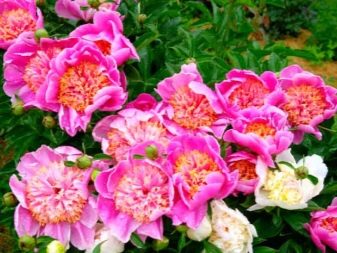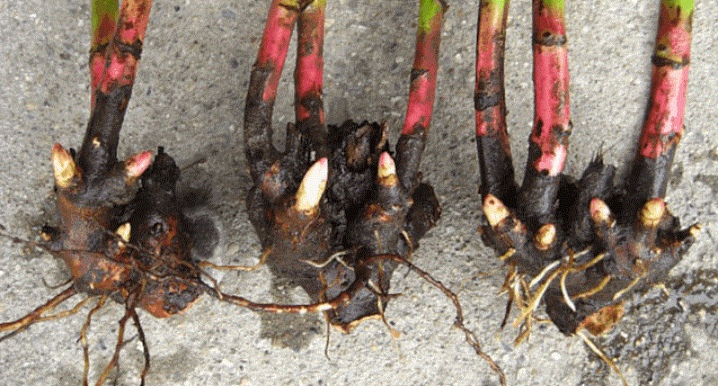All about Japanese peonies

In Chinese and Japanese cultures, the peony has a special place. In these countries, the flower is considered a symbol of beauty. Plants painted in scarlet and pale pink are favorites. Even various beliefs are associated with peonies. For example, the Chinese and Japanese believe that rich red flowers can bring wealth, but pink peonies attract love. These delicate flowers are able to look luxurious almost permanently due to their high level of durability. They can grow in one place for a long time, and are also resistant to low temperatures.

Description
The Japanese peony belongs to the peony family and comes from the genus of perennials. Representatives of this species can be both shrub plantings and herbaceous ones. Let's list the features of the Japanese peony.
- Large root system.
- Shrub plantations can boast of their size. The height of the peony bush reaches 100 centimeters.
- Peony leaves are considered decorative, they are colored green, in some cases they can be purple. During the growing season, peonies often change the color scheme of the leaves.
- The flowers of the plant have a varied shape, it all depends on the variety of peonies.... They are usually spherical, pink and terry in shape. The bud diameter reaches a maximum of 25 centimeters.
- The fruits of the plant consist of many leaflets., each of which contains a small amount of seeds. The seeds are round in shape, colored black.
- Good tolerates drought.
- Possesses a high level frost resistance.
- Loves well illuminated places.
- Long time peony can grow in one place (up to 15 years).
- The flowering of a peony depends on which variety the plant belongs to. Most of it falls at the beginning of the summer season. There are also varieties that bloom in mid-summer. Duration of flowering is from 1 to 3 weeks.
- You can propagate peonies using seeds, layers or cuttings. And also a popular way is the division of the bush.


Japanese peonies are famous for their strength, which helps the bushes not to break their structure even in the worst weather.
Florists give their preference to this type, because their buds are able to open quite easily and quickly, and also beautiful compositions can be created from them. Another advantage of the "Japanese" is the ability to intensive and rapid growth.
Peonies also have a high level of resistance to various pests and diseases.

Varieties
Japanese peonies have not lost their essence in the process of breeding new varieties. Among them, the most popular in our country are several options.



- Jan Van Leeuwen. The stems are very strong and massive, and the flowers on them are cupped. The petals are white, and the core of the flower is decorated with a golden stamen, which is a staminode. And also on the stem there are several lateral buds, thanks to which the shrubs look much more luxuriant, and the peonies bloom much longer. The height of this representative of the Japanese peony is considered average. They perfectly adapt to any bad weather.

- Charles Burges. The flowers of this variety are painted in a deep red color, in the center of the bowl are burgundy staminodes, their tips are curved, and the stamens themselves are narrow and wavy. The stems are also distinguished by their strength, but not massiveness. Support is necessary only in the case of strong overgrowth of the bush.These peonies are of medium height.

- "Neon". The flowers of this representative cannot fail to attract attention, they are painted in a rich pink color. Weather conditions are unable to affect the condition and color of the peony. Staminodes also have a pink tint, and they are yellow at the edges. The bush grows quite tall and strong. Plants called "Neon" are not afraid of any diseases, the variety is quite frost-resistant.

- "Rashumon". The flower calyx is rather large and has a crimson color. The stamens wriggle, and their tips are curled, have a rich yellow color. The stems are not bent and very strong. The height of such plantings is average, as is the flowering period of peonies.

- "Japanese Moon". An ornamental herb, the flowers of which are painted in light green color. Peony leaves are green in color. The period of rapid flowering falls at the beginning of summer. The bush can reach a height of 1 meter. Differs in good resistance to low temperatures.

- Waikiki. Peony buds are large in size, and the petals are painted in a pale white color. When the flower blooms, it shimmers in a pale pink color. The petals of the plant consist of two equal rows, they are characterized by a wide shape. The stems are very thin, but at the same time they firmly fix the buds. The height of the bush is average. This variety is distinguished by its high degree of frost resistance.

- Gold Standard. The bush of this variety grows quite tall and has a large number of stems. This gives the plantings a special splendor. For this reason, at a more mature age, such peonies need support. The flowers of the plant are painted white, the petals are large.

- Nelly Sailor. The scarlet flowers of this variety add elegance to the plant. In the center, small petals formed a small ball, painted in a pale white color. These peonies boast a high level of strength and are above average in size.

There is a huge variety of varieties of Japanese peony in the world, for the most part they have become an irreplaceable part of landscape design, and their characteristics ideal for growing in our country.

Planting and leaving
Caring for a Japanese peony will not take much of your time and effort. You always want decorative flowers to be a worthy decoration in the garden. It is recommended to plant flowers on the southwest side of the garden. Planting is best done in late summer or early fall. You should choose the right place for planting the plant. The peony will grow best in sunny areas. It is also advisable to choose an area that is well protected from the wind.
It is recommended to dig a hole for planting no more than half a meter. The bottom should be sprinkled with sand. It can be mixed with some other auxiliary components, for example, furnace ash. Then the planting hole is filled with water so that the material settles. Further, the mixture is poured almost to the edges of the hole. After that, you can plant peonies. It is better to press the root a little into the soil, cover the bush around the stem with earth a little, while the buds should be level with the ground. It is recommended to cover the plants during the winter period. In this case, you can use the leaves. With the onset of heat, buds are removed on young bushes. This process must be carried out only in the first year after planting the peonies.

It is strongly discouraged to divide the bushes in the spring; it can cause enormous harm to the plant. It is best to do this in the fall, and they are suitable for planting already in the spring season. In winter, planting material is best stored in a cool place and covered with sawdust soaked in moisture. In the process of planting peonies, the buds should be deepened into the soil by about 5 centimeters, no more. This is necessary so that the stem can strengthen, and the flowering is intense. It is possible to divide the bushes of the Japanese peony only in the fourth year, after the plant has been planted in the ground.

When growing such a variety of peonies, it must be borne in mind that they require intensive watering. Thus, you will achieve a dense flowering of shrubs. To prevent water stagnation, it is recommended to mulch the soil around the plant. The layer thickness should not exceed 7 centimeters. Watering is necessary at least 2 times a week. Additional watering will not harm the peonies.

Peonies are well accepted in areas with abundant planting. For the normal growth of shrubs, trees and other flower plantings will not interfere with the development of peonies.
The main thing is that the plant has enough lighting. Crocuses are excellent neighbors for Japanese peonies.

Peonies are often the basis for bouquet arrangements. If you need to cut flowers, it is best to do it in the morning. The weather must be dry.

Below you can watch the newsletter about Japanese peonies.







































































































The comment was sent successfully.